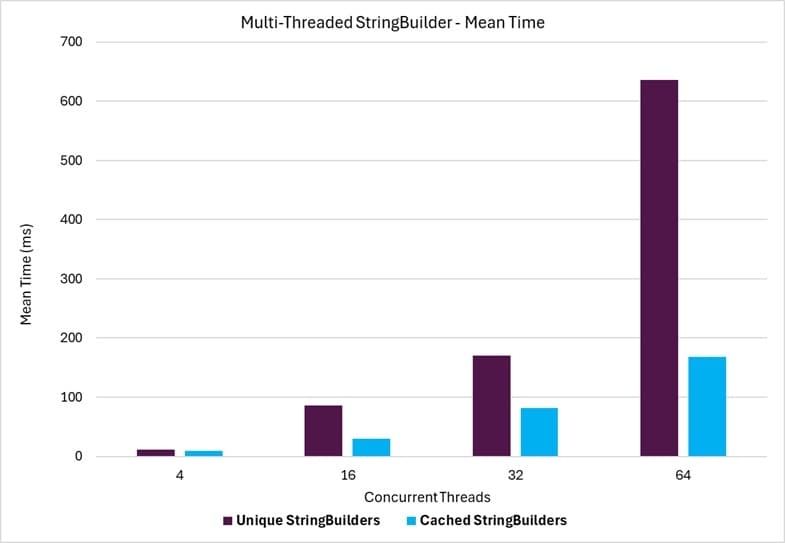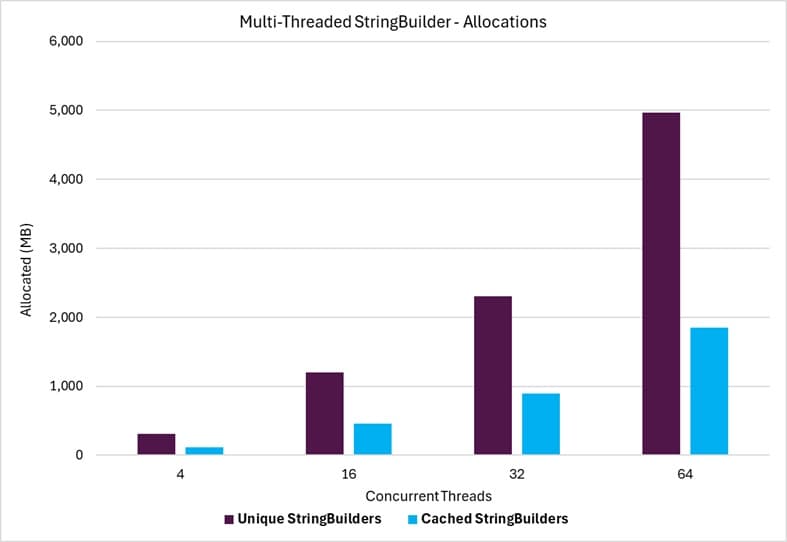Multi-Threaded StringBuilder Throughput Benchmarks
This benchmark compares the throughput performance of StringBuilder class instances managed with the StringBuilderCache class ('Multi-Thread Cached StringBuilders') against operations that instantiate a new StringBuilder class for each use ('Multi-Thread Unique StringBuilders'). The operations are run on multiple threads, with each thread using a single instance of the StringBuilder at a time.
Summary
The benchmark results demonstrate that utilizing the StringBuilderCache class consistently outperforms using unique instances of the StringBuilder class in all scenarios. The throughput performance and memory allocation overhead of the StringBuilderCache class are significantly better than instantiating a new StringBuilder instance for each use. By reusing instances of the StringBuilder class, the StringBuilderCache eliminates the overhead of creating and disposing of instances and their internal buffers, improving both performance and memory efficiency.
Benchmark Operations
A single benchmark operation consists of running multiple threads simultaneously, where each thread performs a loop 10,000 times with the following steps:
- Acquire an instance of the StringBuilder class.
- Append pre-allocated test string segments to the StringBuilder instance.
- Retrieve the built string from the StringBuilder instance.
- Release the StringBuilder instance back to the cache.1
Benchmark Parameters
The following parameter was used in the benchmarks. Along with the standard BenchmarkDotNet columns, it appears as a column in the benchmark results.
ThreadCount
This parameter indicates the number of threads used in the benchmark operations. Each thread simultaneously runs the same operation loop. A benchmark operation is complete when all threads have finished their operation loops.
Examples
Throughput Time
The following graph shows the throughput time when comparing unique StringBuilder instances to StringBuilderCache. The horizontal axis represents the number of concurrently running benchmark threads, and the vertical axis shows the time in milliseconds.

Allocations
The following graph shows the memory allocations incurred when comparing unique StringBuilder instances to StringBuilderCache. The horizontal axis represents the number of concurrently running benchmark threads, and the vertical axis shows the memory allocations in MB.

HTML Report
Since the benchmark results can create large tables that are difficult to navigate due to horizontal and vertical scrolling, the results are also provided in a simplified HTML table format.
The HTML report can be found here.
-
This step applies only to the StringBuilderCache case. For the unique StringBuilder case, the StringBuilder instance is simply garbage collected.↩